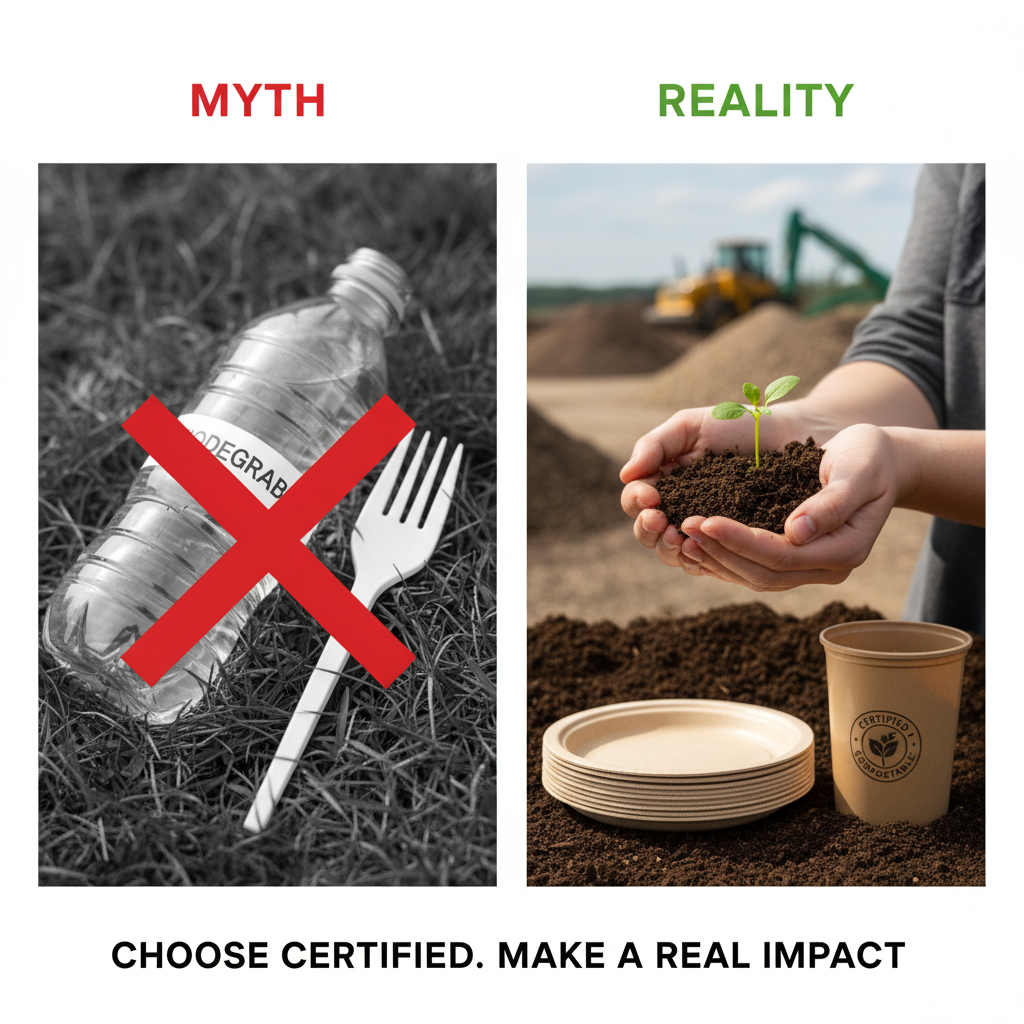
5 Common Myths About Biodegradable and Compostable Products, Debunked
Share
In the quest for a more sustainable lifestyle, eco-friendly disposables like sugarcane bagasse tableware and other plant-based products have emerged as heroes. However, the world of "green" packaging is often shrouded in confusion, misinformation, and a fair bit of greenwashing.
Terms like "biodegradable" and "compostable" are thrown around, often leaving consumers and businesses unsure if they're truly making a difference. It's time to clear the air.
Here are 5 common myths about biodegradable and compostable products, thoroughly debunked, to help you make truly informed and sustainable choices.
Myth 1: "Biodegradable" Means It's Good for the Environment and Will Disappear Quickly.
The Reality: This is perhaps the biggest and most misleading myth. While it sounds good, "biodegradable" simply means a material can be broken down by microorganisms. The critical missing information is under what conditions and how long it will take.
- No Time Limit: There's often no regulated time frame attached to "biodegradable." A plastic bottle could be labelled "biodegradable" if it breaks down in 500 years instead of 1,000.
- Specific Environments: Many "biodegradable" plastics only break down in very specific, often artificial, industrial conditions that are rarely found in nature or even in a typical landfill. They might require sustained high temperatures, UV light, or unique microbial populations.
- Microplastic Risk: Some "biodegradable" plastics simply fragment into smaller and smaller pieces of plastic (microplastics) rather than truly assimilating back into the environment.
The Truth: For a product to be truly eco-friendly, it needs to be certified compostable, which comes with strict standards for breakdown within a specific timeframe in a controlled environment.
Myth 2: All "Compostable" Products Will Break Down in My Backyard Compost Bin.
The Reality: While fantastic products like bagasse plates can often be home composted, the majority of items labeled "compostable" (especially bioplastics like PLA) are certified for commercial composting facilities only.
- Temperature Matters: Commercial composting facilities operate at consistently high temperatures (often above 140°F / 60°C) for sustained periods. These conditions are necessary to break down tougher materials and kill pathogens.
- Home vs. Commercial: Your backyard pile, while wonderful for food scraps and yard waste, typically doesn't reach or sustain these high temperatures. Materials that require commercial composting will simply sit in a home pile without breaking down, or break down extremely slowly.
- Check the Label: Always look for specific certifications (like BPI or Seedling) and explicit labeling that states "home compostable" if you intend to put it in your backyard bin. Otherwise, assume it requires a commercial facility.
The Truth: Never assume! Unless explicitly stated as "home compostable," most certified compostable items (including many eco disposable cups and compostable cutlery) need to go to a specialized commercial composting facility.
Myth 3: Compostable Products Just Turn into Sludge and Aren't Really Useful.
The Reality: When processed correctly in a commercial composting facility, compostable products, along with food waste and other organic materials, transform into a valuable, nutrient-rich soil amendment.
- Soil Enrichment: This finished compost is used to enrich agricultural land, gardens, and landscaping. It improves soil structure, water retention, and nutrient availability, reducing the need for chemical fertilizers.
- Reduces Landfill Waste: By diverting food scraps and compostable packaging from landfills, we reduce methane gas emissions (a potent greenhouse gas) and extend the life of our landfills.
The Truth: High-quality compostable products contribute directly to creating beneficial soil, closing the loop on a truly sustainable resource cycle.
Myth 4: Compostable Packaging is Always More Expensive and Not Worth the Cost.
The Reality: While historically this might have been true, the gap in pricing between conventional and truly eco-friendly packaging is rapidly shrinking. Moreover, focusing solely on the upfront cost misses the broader value.
- Consumer Demand: Consumers are increasingly willing to pay more for sustainable options. Restaurants and businesses using compostable takeout containers often see increased customer loyalty and a stronger brand image, leading to higher sales.
- Regulatory Compliance: As plastic bans become more widespread, investing in compostable alternatives now can save you from costly last-minute switches, fines, and operational disruptions later.
- Reduced Waste Costs: In some areas, diverting compostable waste can lead to reduced landfill disposal fees.
The Truth: The investment in compostable packaging offers significant returns in brand value, customer satisfaction, and future-proofing your business.
Myth 5: You Can Just Throw Compostable Products in with Your Recycling.
The Reality: Never mix compostable products with your recycling stream! This is a critical mistake that can contaminate an entire batch of recyclables, rendering them unusable.
- Different Materials: Compostable items (especially bioplastics like PLA) look and feel like traditional plastics but are made from entirely different polymers. Recycling facilities are not equipped to separate or process them.
- Contamination: When compostable items enter the recycling stream, they are considered contaminants. This means that valuable recyclable materials might end up in a landfill because they can't be properly sorted and reprocessed.
- "Wish-cycling": The act of putting items in the recycling bin hoping they'll be recycled, even if you're unsure, often does more harm than good.
The Truth: Compostable products belong in a compost bin (home or commercial), not a recycling bin. Proper sorting is essential for both recycling and composting to be effective.
Make Informed Sustainable Choices
Navigating the world of eco-friendly disposables requires a discerning eye. By understanding these common myths, you can move beyond greenwashing and confidently choose products like sugarcane bagasse that truly deliver on their promise of a greener future. Always read labels, understand your local waste infrastructure, and prioritize certified compostable options.
